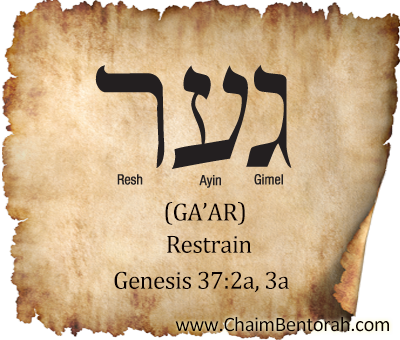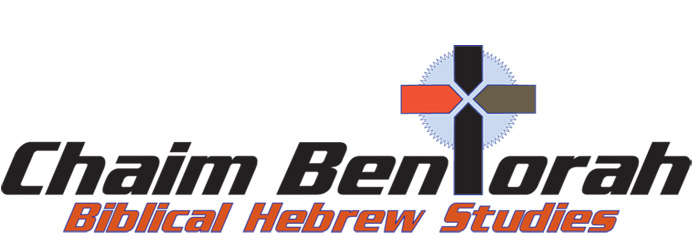Hebrew Word Study – Restrain – Ga’ar
 Genesis 37:2a, 3a: “These are the generations of Jacob… (3a) Now Israel loved Joseph more than all his children, because he was the son of his old age:”
Genesis 37:2a, 3a: “These are the generations of Jacob… (3a) Now Israel loved Joseph more than all his children, because he was the son of his old age:”
In this passage on the story of Jacob and Joseph, we find in verse 2 of Genesis 37 that Jacob is called Jacob, which means usurper or supplanter that is to take the place of someone or something. Then in the very next verse, he is called Israel or Yishrael in Hebrew. That is the name God gave him after he wrestled with an angel all night. Various meanings of the word Israel have been given. Some say the root word is sharah which has an uncertain meaning. It is generally believed to mean striving, persistence, and/or perseverance. The El at the end of the word is for God, and so Israel could mean God who strives, who is persistent and/or persevering. Some have suggested sharah means to be princely as a verb, and the yod puts it in an imperfect inflection therefore, Israel would mean he will be a prince with God. Some suggest the root word is yashar, meaning to be upright hence a reference to the uprightness or righteousness of God.
What is important to know is that the word and name Israel have a positive meaning, whereas the word Jacob as supplanter, well, not so much. The Talmud, in fact, tells us that when the name or word Jacob is applied to the nation of Israel, it is usually in reference to Israel when they are not in full obedience to God, and when the name Israel is applied to the nation it is showing God’s favor upon the land and people. This would also apply to the man Jacob/Israel, and hence to use the name Israel in Genesis 37:2 in relationship to words Israel loving Joseph more than all his children rather than Jacob loving Joseph more than all his children is a remez. Remez means a hint. There is a hint in the use of the word Israel rather than Jacob. Many times a remez is indicated by a scribal notation known as a tittle. Remember Matthew 5:18: “For assuredly, I say to you, till heaven and earth pass away, one jot or one tittle will by no means pass from the law till all is fulfilled.” We talk about this in our online classes on our All-Access membership site.
Would you like Chaim Bentorah as your personal Hebrew teacher?
|
|
Looking unto Jesus is not just looking at him but making yourself transparent to Him as he makes Himself transparent with you. It is like a bride and groom looking at each other as they commit themselves to each other for the rest of their lives. At that moment they become transparent, sharing something with each that they will not share with anyone else in the world.
The wedding motif actually carries on through this entire verse. Jesus endured the cross and the shame associated with the cross for the joy that would result from it. He did it not only for us but for the joy that the sacrifice would bring to Him. Just as the bride and groom sacrifice their personal lives and their singleness for the joy of being together. Yet, that word joy is an amazing word to use here in this passage. It is the word chadotha in the Aramaic. This is the word used for the joyful dancing at a wedding. This again carries that wedding motif. The vows have been said as we and Jesus gaze at each other sharing our vows. We tell Jesus that we are giving Him our lives and our hearts and now we enter that wedding feast where there is a wedding dance. In the traditional wedding dance couples line up opposite each other. Depending on the culture and whether traditional orthodox or not either men and women face each other or members of the same sex face each other, the symbolism still remains the same. They then move toward each other and then back away, always chor, gazing at each other, never taking the eyes off each other. Each time they back away, they move back to each other only this time drawing closer to each other. This is to declare that the bride and groom will have times when they will struggle in their marriage and they will momentarily separate from each other, but as they look chor or gaze at each other they will be drawn back to each other only this time a little closer. This is what the Apostle Paul is describing in this wedding motif that we will dance this wedding dance. It is a joyful time of expressing our commitment with Jesus and He with us. Even though we may sin and draw away from Jesus, He will always keep His gaze on us and we will be drawn back to Him only each time we return we will be drawn closer to Him. Jesus will use our human frailties that the enemy would seek to use to draw us away from Him only Jesus will use it to bring us closer to Him.
So we have the wedding ceremony where we gaze at Jesus in transparency leading us to the joy of the wedding dance and now the groom takes his place at the right hand of the Father at his daqurasih in Aramaic from the root word quras which is a chamber with an upholster chair or a divan, what we call a love seat, that is a chair made for two people to sit closely together. It could also be a bedroom and the way the syntax word suggest we could read this as the bedroom in His Father’s house. This is where the groom Jesus would take us His bride to consummate our marriage to Him.
So next time you hear this verse, stop and consider that the Apostle Paul might be sharing something even more intimate than we the surface understanding of this verse indicates. It is also speaking of our marriage relationship to Jesus and the intimacy that He longs so much to have with us that he endured the suffering of the cross in order to obtain it.
Hi there! Thank you for reading this Daily Word Study. Can I ask a favor? Share this Daily Word Study with your friends on Facebook and Twitter by clicking one of the icons below.
Thanks & Blessings, it means a lot to me!







Than you for sharing! I enjoy these teachings!
Ga ar, to restrain, Ruach Hakodesh, the restrainer💗 Shabbat Shalom! Thank you for teaching mi’Lashon Hakodesh
I am missing the verse cited as Paul’s referred in the article …
Beautiful
I usually feel the flow in the articles. Did I miss the connection between restrain and “Jacob” “Israel” and the switch to marriage?
BTW. Your posts always inspire me! I pray the Lord bless you with even more intimacy and revelation – that you may declare His glory as you are doing! You are a gift to us all.